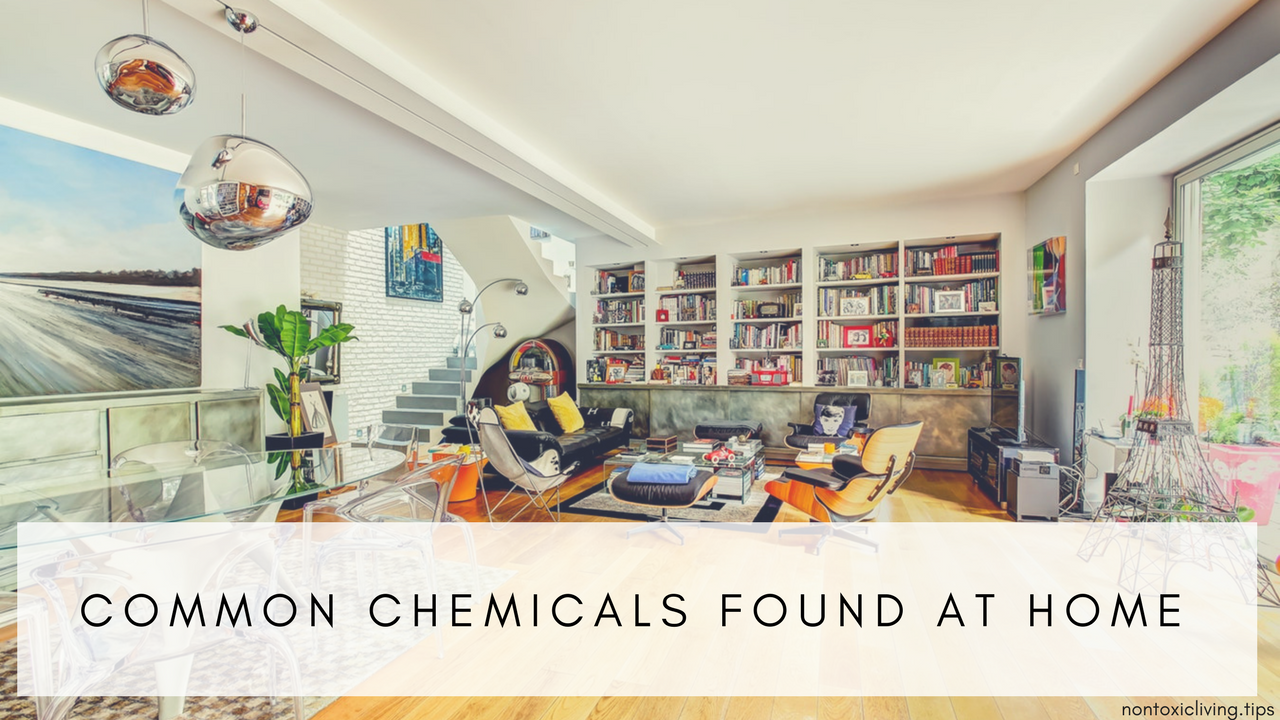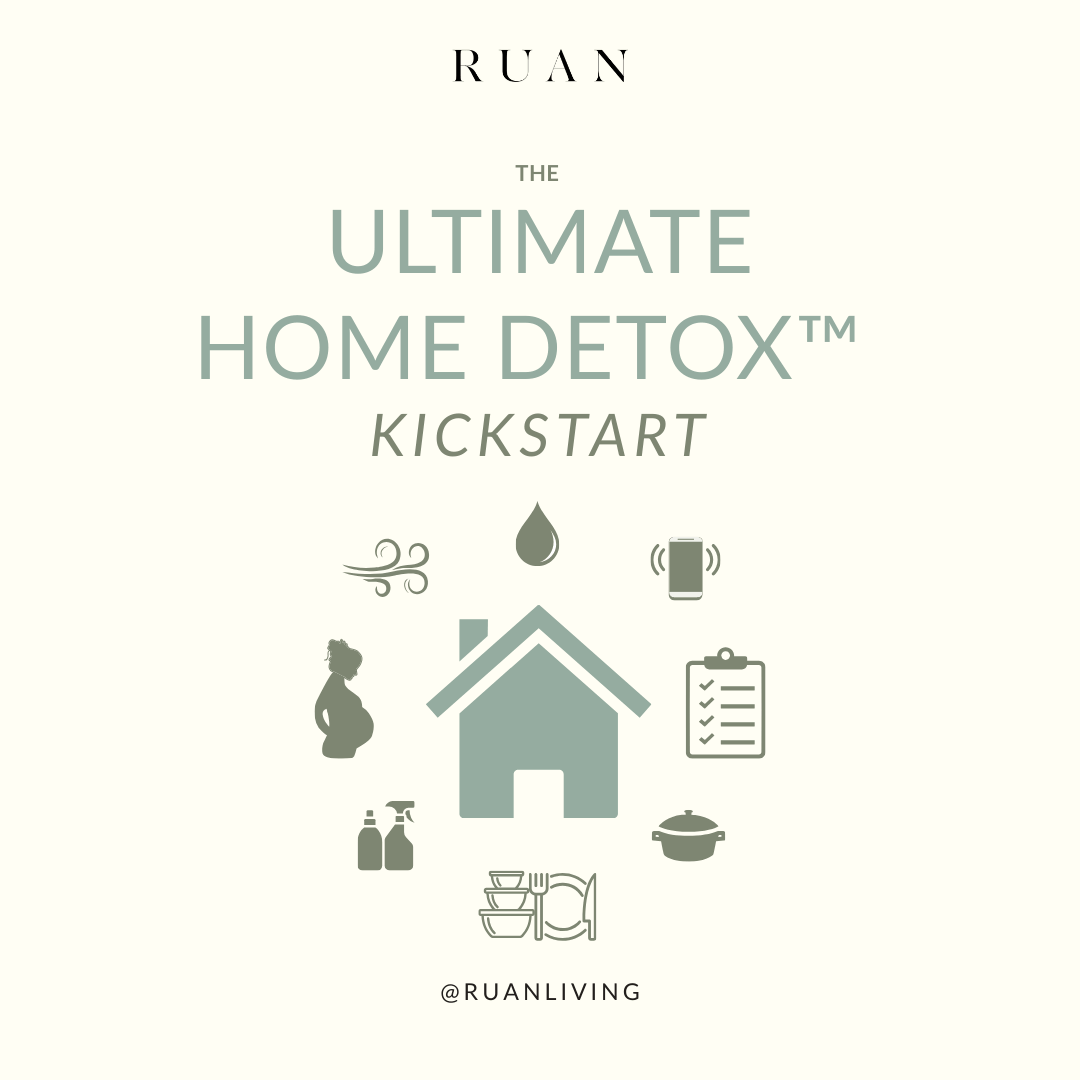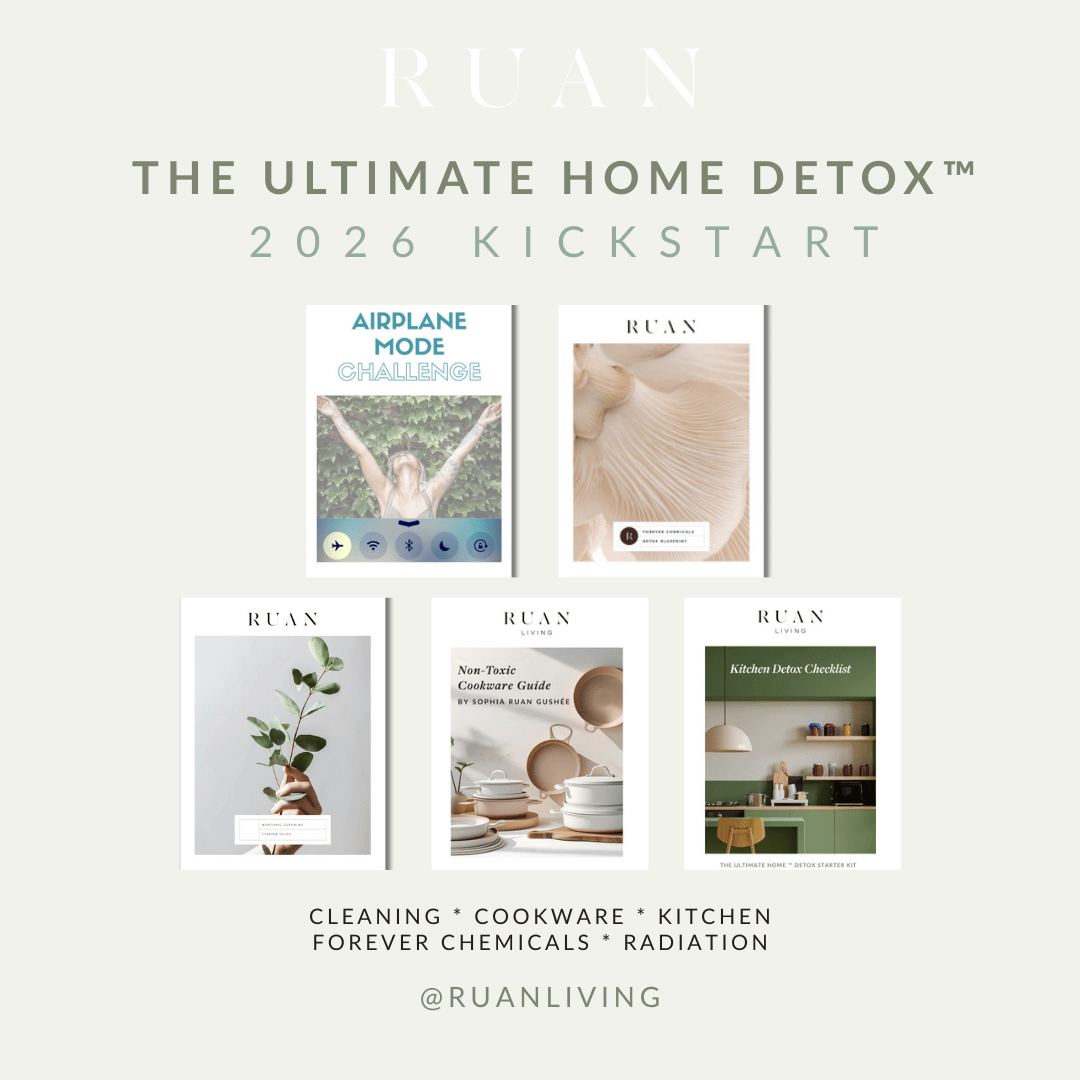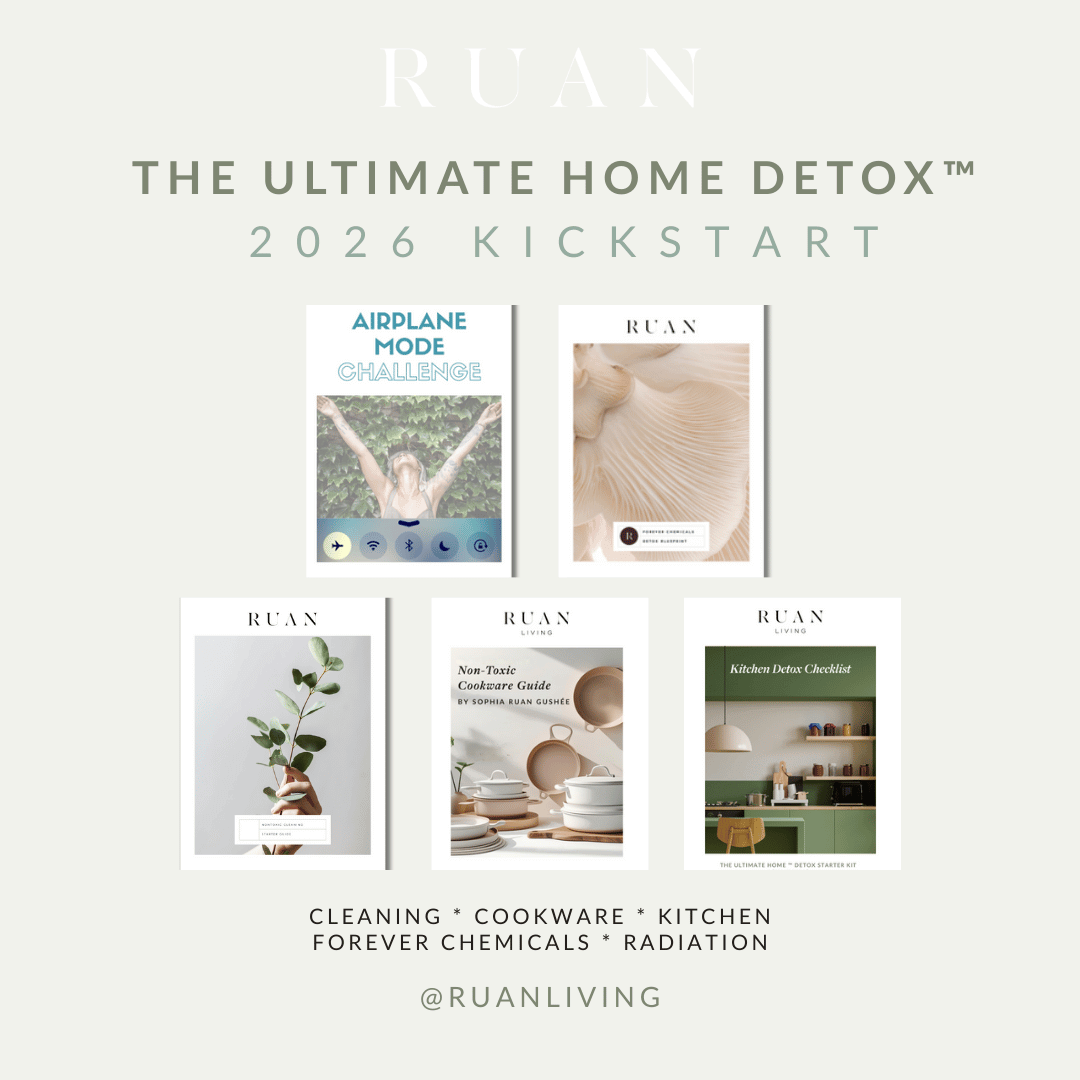
Top Chemicals Found in the Home
Jan 18, 2018by Angela Cummings and Sophia Ruan Gushée
Chemicals, chemicals here and there. Chemicals, chemicals everywhere!
It’s true. They’re all around us, which can be overwhelming at times.
How do you choose which chemicals to tackle first? Based on the book A to Z of D-Toxing: The Ultimate Guide to Reducing Our Toxic Exposures by Sophia Gushée, the top 10 chemicals (or families of chemicals) of concern and their health effects are described below. This list of common household chemicals can be used to learn, focus efforts, and strategize which chemicals to avoid.
Take a room-by-room tour of places where chemicals may be in your home.
1. KITCHEN
Cabinets & Shelves
Kitchen cabinets consume large amounts of wall space, holding dishes and packaged foods. Their beauty is one of the main focuses of a kitchen and can be seen by all.
What can’t be seen are the chemicals used to make those chemicals and shelves. Cabinets and shelves can contain chemicals from a family of chemicals known as solvents. Solvents are often used to make composite wood, paints, stains, and finishes.
- Chemicals. Solvents are used to create solutions, minimize clumping, and increase dry times. They are often used in adhesives and resins that bind wood dust when making composite wood. Solvents may affect the nervous, reproductive, development, liver, kidney, and respiratory systems. They may also cause cancer.
- Tips. Cabinets and shelves made from solid hardwood and finished with natural nontoxic paints, stains, and finishes are preferable. As a standard cabinet-building practice today, plywood is typically used to build the cabinet box (framework) and for the back panel (which holds the cabinets square and sturdy). Cabinet faces and doors (the part we see most) are typically made from composite wood, but is often available in solid hardwood. For the most nontoxic cabinets, cabinets made entirely of solid hardwood is ideal but is also expensive. When considering how to prioritize your budget, solid wood may not be a worthwhile option so choose composite woods that are free of formaldehyde. Focusing on which stains, adhesives, and paints you use are more affordable ways to detox your wood products.
Electronics
Electronics are everywhere: Computer stations for working, tablet devices displaying recipes, and “smart appliances” to remotely control settings and inform you when your steak is ready! Electronic devices heat up when in use. In order to minimize (and hopefully avoid) a fire hazard, chemical flame retardants are added to electronics.
- Chemicals. Chemical flame retardants have been linked to health conditions that involve the immune, endocrine, reproductive, developmental and nervous systems. They also may contribute cancer.
- Tips. Minimize the amount of electronics in your home. Since flame retardants are required by law to be added to electronics, the best way to minimize exposure from electronics is to minimize how much you have at home. As a bonus, this will help minimize electromagnetic fields.
2. LIVING ROOM
Furniture
There are many parts to furniture: the structure, padding, covering, and finishes that require different types of material. For example, furniture structure can be made from wood varieties, metal, and plastic, while padding can be made from foam, latex, cotton, or wool. Coverings can be made from leather varieties, synthetic materials, and have various fabric finishes; while wood finishes could be in the form of paint, stains, and sealants. In any style of furniture, there can be chemicals classified as volatile organic compounds (VOCs).
- Chemicals. Volatile Organic Compounds (VOCs) fall within the solvent chemical family. VOCs can affect health both in the short-term and long-term. The impact can range from irritation of the eyes and respiratory system to dizziness and nausea to cognitive inabilities. Long-term effects can include damage to organ systems (such as the liver and kidneys), and the nervous system. VOCs may also contribute to cancer.
- Tips. Furniture made from natural materials—such as hardwood, cotton, and wool—typically have fewer VOCs than furniture made from synthetic materials, like composite woods, foam, and polyester. If the furniture has a paint, stain, or sealant, choose zero- or low-VOC products.
Drapes, Blankets & Coverings
Stain repellent fabric can be found in furniture coverings, drapes, and blankets, making them easily cleanable when liquid is spilled or splashed onto them. One of the chemicals used to create a stain repellent is in the nanoparticle family. Antimicrobials are also in this family of chemicals.
- Chemicals. Nanoparticles that have been tested on animals have resulted in behavior, metabolism, inflammation, damage to cell structure, development issues, and neurological damage. The effect on humans is unknown but thought to easily affect the human brain and organs since their minuscule size could more easily travel into the body.
- Tips. Manufacturers are not required to include nanoparticles on labels, making it tough for consumers to avoid. Initial tips for avoiding them are twofold: avoid sprays and powders with nanoparticles (or minimize sprays and powders in general), and avoid applying creams with nanoparticles over cuts (or avoid applying creams, lotions, etc. over open wounds as a general rule).
3. BATHROOM
Soaps, Toothpastes, Shaving Creams & Other Personal Care Items
Personal care items—such as soaps, toothpastes, shaving creams, and facial scrubs—often contain tiny plastic pieces called microbeads. They’ve been used to give a little abrasion to otherwise smooth products to help exfoliate and give texture.
- Chemicals. Microbeads added to products is a relatively new fad so the health effects are not fully known yet, but dentists suspect that microbeads may be contributing to dental-related diseases. The tiny pieces of plastic can get stuck in the gums and between teeth, and trap bacteria. The environmental impact may be significant and lead to an impact on human health. Water treatment equipment is not able to catch such small plastic particles,, causing the microbeads to end up in lakes. The microbeads look like fish eggs, which may be eaten by fish and other lake-residing animals. And humans could be eating those fish. (1)
- Tips. Exfoliate with natural products—like salt, sugar, or ground nut shells—that can be easily added to nontoxic soaps to give a similar lightly-abrasive texture to your cleaners. Loofah sponges are another natural alternative. Be sure to dry the sponge completely so that it doesn’t mold.
Cosmetics & Hair Styling
Beauty products such as cosmetics and hair styling gels and sprays make us look marvelous on the outside, but may harm our insides. Petroleum distillates are one of several chemicals found in personal care products, such as lip balms, mascaras and hair products.
- Chemicals. Petroleum distillates are made from crude oil (the same oil used to make gasoline and kerosene) that has been distilled, processed, and refined. They accumulate in bodies and may contribute to cancer. It has been prohibited or restricted in the European Union, but is still used in the U.S.
- Tips. Petroleum distillates are required to be listed on product labels, making it easier to spot products that contain it. The complexity comes in the number of names for petroleum distillates. Here are a few names that are more commonly known: petroleum, petroleum jelly, mineral oil, mineral spirits, kerosene, white spirits. Choose cosmetics and hair sprays that don’t contain these ingredients. Look for cosmetics, hair styling, and other personal care products that are made from natural ingredients.
4. NURSERY
Children’s Stuff
Little babies urinate approximately 20 times per day and need their diaper changed every 2-3 hours.(2) That means their little butts are wiped 8-12 times per day. Those baby wipes commonly contain chemicals, including glycols.
- Chemicals. Glycols are a type of alcohol that is used to clean the skin and prevent moisture loss. They have been found to cause dermatitis (skin condition), birth defects, and damage the reproductive and kidney systems.
- Tips. Wipe little butts with organic, reusable, cotton cloths (wash cloth or cloth diaper), damp paper towel, toilet paper, or cotton balls. If standard wipes are used, select those that are unbleached, chlorine-free, alcohol-free, paraben-free, and fragrance-free.
Toys
Children’s toys, such as bath toys and sponges, sometimes have antibacterial chemicals—such as triclosan—added to them to keep the toy from molding. Some toy manufacturers and distributors suggest cleaning the toy with antibacterial soap. While well-intended, the chemicals used to create antibacterial products may be harmful to health.
- Chemicals. Triclosan is an antibacterial and disinfectant. It may be affecting health by disrupting thyroid and other hormones, and doing harm to the liver and immune system. The U.S. Environmental Protection Agency regulates the use of triclosan (and other antimicrobials) as a pesticide in products like counter cleaners, and the U.S. Food and Drug Administration regulates triclosan (and other antimicrobials) as drugs and antiseptic products such as hand cleaners.(3)
- Tips. Avoid cleaning toys with antibacterial soaps or sprays. Toys that are labeled “antibacterial” may contain triclosan or other chemicals linked to health conditions. Third-party organizations such as HealthStuff (https://www.ecocenter.org/healthy-stuff) has a searchable database and develops reports advising of healthier products, including children’s toys.
5. WHOLE HOUSE
Cleaning Products
Cleaning products made from chemicals have gained attention in mainstream media over the past few years and continues to be a concern for many. Used on counters, floors, bathtubs, sinks, windows, and a host of other surfaces that we encounter several times per day, cleaning products often contain preservatives (such as formaldehyde and sodium benzoate). The cleaning products used in a home can be isolated to a single room (such as bathroom toilet cleaner) to the entire house (a multipurpose cleaner).
- Chemicals. Preservatives can cause short-term and long-term health conditions. They have been linked to cancer, behavior disorders, menstrual cycle disruption, and irritation of the eyes, nose, throat and skin.
- Tips. Use cleaning products made from natural ingredients—such as vinegar, water, baking soda, hydrogen peroxide, and castile soap. Instead of buying pre-mixed cleaners, make your own!
Air Fresheners
Air fresheners typically contain synthetic fragrances, which are made from any number of chemicals. Inerts are one type of chemical that can be found in synthetic fragrances. The word “inert” means “lacking a usual or anticipated chemical or biological action”(4), giving the impression that these chemicals are not harmful. However, that doesn’t seem to be the case.
- Chemicals. Inerts have not been studied for their health effects. However, the U.S. Environmental Protection Agency allows 1,400 chemicals to be called inert, 40 of which are known to cause cancer or nervous system toxicity, and another 64 of which are potentially toxic.
- Tips. Instead of standard air fresheners, use organic essential oils that are made from natural sources instead of synthetic chemicals. Simmering water on the stove, and adding lemon, cinnamon or other spice is another healthier alternative to synthetic air fresheners.
Chemicals are found throughout our homes. The 10 chemicals identified above are categories that are commonly found in households. Make changes room-by-room to rid these common household chemicals and unburden your body.
References
(2) American Pregnancy Association



